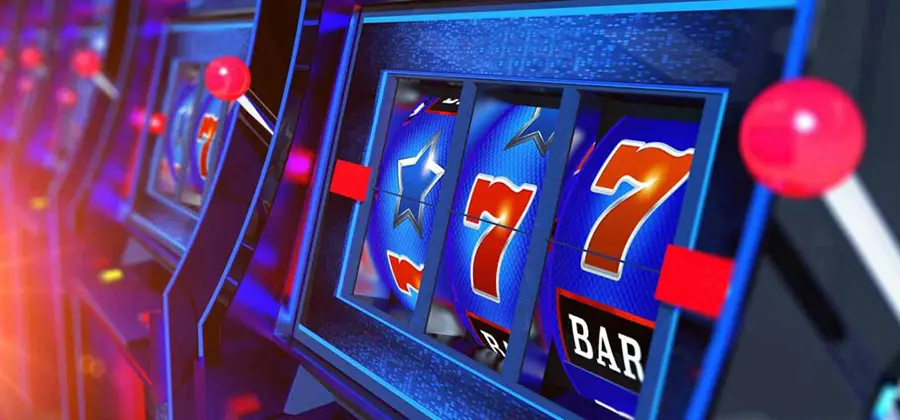Slot games are a popular form of entertainment in casinos worldwide. They offer excitement, anticipation, and the chance to win big. But behind the spinning reels and flashing lights lies a concept that can significantly impact your gaming experience: volatility. Understanding slot game volatility is crucial for players who want to make informed decisions and maximize their enjoyment. Volatility, also known as variance, refers to the risk level associated with a particular slot game. It determines how often and how much a player can expect to win. By grasping the concept of volatility, players can choose games that align with their risk tolerance and gaming preferences. This post will delve into the intricacies of slot game volatility, exploring its influence on payouts, the differences between high and low volatility slots, and how it affects strategies and bonus features. Whether you’re a seasoned player or new to the world of slots, understanding volatility can enhance your gaming experience.
What is Slot Game Volatility?
Slot game volatility is a measure of risk and reward. It indicates how often and how much you can expect to win. High volatility means bigger wins but less frequently. Low volatility offers smaller, more frequent payouts. Volatility is a crucial factor in slot games. It helps players understand what to expect from a game. Knowing the volatility can guide your choice of slots. It can also influence your strategy and bankroll management. Volatility is not the same as Return to Player (RTP). RTP is the percentage of wagered money a slot returns to players over time. Volatility focuses on the distribution of wins. It tells you if a game is risky or safe. High volatility slots are for thrill-seekers. Low volatility slots suit those who prefer steady wins. Understanding volatility helps you make informed decisions. It enhances your gaming experience. Choose the right volatility level for your style. Enjoy the game with confidence.
How does volatility influence slot payouts?
Volatility plays a significant role in determining slot payouts. It affects the frequency and size of wins. High volatility slots offer larger payouts but less often. These games are unpredictable. They can lead to big wins or long losing streaks. Low volatility slots provide smaller, more frequent payouts. They offer a steady stream of wins. This makes them less risky. Volatility influences your gaming experience. It determines how thrilling or relaxed a game feels. High volatility slots are exciting. They keep you on the edge of your seat. Low volatility slots are more predictable. They offer a consistent flow of wins. Volatility also impacts your bankroll. High volatility games require a larger bankroll. They can deplete your funds quickly. Low volatility games are more budget-friendly. They allow for longer play sessions. Understanding volatility helps you choose the right game. It aligns your expectations with the slot’s payout pattern. Make informed decisions and enjoy your gaming experience.
Understanding high volatility slots
High volatility slots are thrilling and unpredictable. They offer the chance for big wins. But these wins are rare. High volatility means high risk. These games can lead to long losing streaks. But when you win, the payout is substantial. High volatility slots are for risk-takers. They appeal to players who enjoy excitement. These games require patience and a larger bankroll. High volatility slots often have bonus features. These features can lead to massive payouts. But triggering them can take time. Players need to be prepared for dry spells. High volatility slots are not for everyone. They suit players who can handle risk. These games offer a roller-coaster experience. They keep you on the edge of your seat. Understanding high volatility is crucial. It helps you manage your expectations. Choose high volatility slots if you enjoy risk. Be prepared for ups and downs. Enjoy the thrill of the game.
What are low volatility slot games?
Low volatility slot games offer a different experience. They provide smaller, more frequent wins. These games are less risky. They suit players who prefer steady payouts. Low volatility slots are predictable. They offer a consistent flow of wins. This makes them ideal for casual players. These games are budget-friendly. They allow for longer play sessions. Low volatility slots are relaxing. They provide a laid-back gaming experience. Players can enjoy the game without stress. Low volatility slots often have simple gameplay. They focus on regular payouts. Bonus features are less common. But they can still offer excitement. Low volatility slots are perfect for beginners. They help players build confidence. Understanding low volatility is important. It helps you choose the right game. Align your expectations with the slot’s payout pattern. Enjoy a steady gaming experience. Choose low volatility slots for a relaxed session. Enjoy the game at your own pace.
How to choose the right volatility level for you
Choosing the right volatility level is crucial. It depends on your risk tolerance. High volatility slots are for thrill-seekers. They offer big wins but are risky. Low volatility slots are for cautious players. They provide steady, smaller wins. Consider your bankroll. High volatility games require a larger budget. Low volatility games are more budget-friendly. Think about your gaming goals. Do you want excitement or relaxation? High volatility slots offer excitement. Low volatility slots offer relaxation. Consider your experience level. Beginners may prefer low volatility slots. Experienced players might enjoy high volatility games. Test different slots. Find what suits your style. Pay attention to the game’s features. High volatility slots often have bonus features. Low volatility slots focus on regular payouts. Understanding volatility helps you make informed decisions. Choose the right game for your preferences. Enjoy your gaming experience. Play with confidence and have fun.
Impact of volatility on slot machine strategies
Volatility influences slot machine strategies. It affects how you approach the game. High volatility slots require patience. They can lead to long losing streaks. But they offer big wins. Manage your bankroll carefully. Be prepared for ups and downs. Low volatility slots offer steady wins. They suit players who prefer consistency. These games allow for longer play sessions. Volatility impacts your betting strategy. High volatility slots may require larger bets. Low volatility slots allow for smaller bets. Adjust your strategy based on the game’s volatility. Consider your risk tolerance. High volatility slots are for risk-takers. Low volatility slots are for cautious players. Volatility also affects your gaming goals. Do you want excitement or relaxation? High volatility slots offer excitement. Low volatility slots offer relaxation. Understanding volatility helps you develop a strategy. Choose the right game for your style. Play with confidence and enjoy the game.
Volatility vs. RTP: What’s the difference?
Volatility and RTP are different concepts. Volatility measures risk and reward. It indicates how often and how much you can win. RTP stands for Return to Player. It is the percentage of wagered money a slot returns to players over time. Volatility focuses on the distribution of wins. RTP focuses on the overall payout percentage. High volatility slots offer big wins but less often. Low volatility slots provide smaller, more frequent wins. RTP is a long-term measure. It doesn’t guarantee short-term results. Volatility affects your gaming experience. It determines how thrilling or relaxed a game feels. RTP affects your potential returns. It indicates the slot’s payout potential. Understanding both concepts is crucial. It helps you choose the right game. Align your expectations with the slot’s characteristics. Choose high volatility slots for excitement. Choose low volatility slots for steady wins. Consider RTP for potential returns. Make informed decisions and enjoy your gaming experience.
How to manage bankroll with different volatility levels
Managing your bankroll is crucial. Volatility affects your approach. High volatility slots require a larger bankroll. They can lead to long losing streaks. Be prepared for ups and downs. Set a budget and stick to it. Low volatility slots are more budget-friendly. They offer steady, smaller wins. These games allow for longer play sessions. Adjust your bankroll strategy based on volatility. Consider your risk tolerance. High volatility slots are for risk-takers. Low volatility slots are for cautious players. Set limits for yourself. Decide how much you’re willing to lose. Don’t chase losses. Take breaks if needed. Volatility impacts your betting strategy. High volatility slots may require larger bets. Low volatility slots allow for smaller bets. Manage your bankroll carefully. Choose the right game for your style. Play with confidence and enjoy the game. Make informed decisions and have fun.
Examples of popular high volatility slots
High volatility slots are thrilling. They offer big wins but are risky. Popular examples include “”Book of Dead.”” This game is known for its excitement. It offers massive payouts. “”Dead or Alive”” is another favorite. It has a Western theme and big win potential. “”Bonanza”” is a popular choice. It features a unique Megaways mechanic. These games are for risk-takers. They require patience and a larger bankroll. High volatility slots often have bonus features. These features can lead to massive payouts. But triggering them can take time. Players need to be prepared for dry spells. High volatility slots are not for everyone. They suit players who can handle risk. These games offer a roller-coaster experience. They keep you on the edge of your seat. Understanding high volatility is crucial. It helps you manage your expectations. Choose high volatility slots if you enjoy risk. Be prepared for ups and downs. Enjoy the thrill of the game.
Can volatility affect bonus features in slots?
Volatility can impact bonus features. High volatility slots often have exciting bonuses. These features can lead to big wins. But triggering them can take time. Players need patience. Low volatility slots may have simpler bonuses. These features offer steady payouts. They are easier to trigger. Volatility affects the frequency of bonuses. High volatility slots offer rare bonuses. But they can be lucrative. Low volatility slots offer frequent bonuses. But the payouts are smaller. Understanding volatility helps you choose the right game. Consider your preferences. Do you want excitement or steady wins? High volatility slots offer thrilling bonuses. Low volatility slots offer consistent features. Volatility also impacts your strategy. High volatility slots require patience. Low volatility slots allow for longer play sessions. Choose the right game for your style. Enjoy the bonus features. Play with confidence and have fun.
Understanding slot game volatility is essential. It influences your gaming experience. Volatility affects payouts, strategies, and bonus features. High volatility slots offer big wins but are risky. Low volatility slots provide steady, smaller wins. Choose the right volatility level for your style. Consider your risk tolerance and bankroll. Volatility and RTP are different concepts. Both are important for informed decisions. Managing your bankroll is crucial. Adjust your strategy based on volatility. High volatility slots require patience. Low volatility slots offer longer play sessions. Popular high volatility slots offer thrilling experiences. Volatility impacts bonus features. Choose the right game for your preferences. Enjoy your gaming experience. Play with confidence and have fun. Understanding volatility enhances your enjoyment. Make informed decisions and maximize your experience. Whether you seek excitement or relaxation, there’s a slot game for you. Enjoy the thrill of the game.


